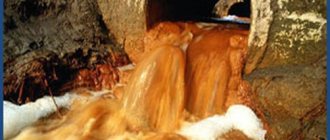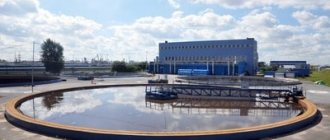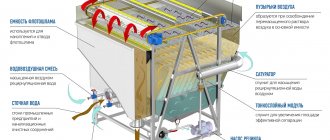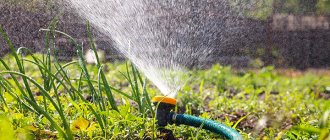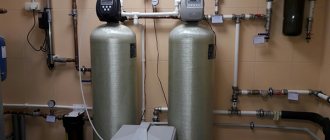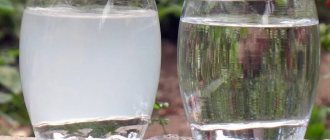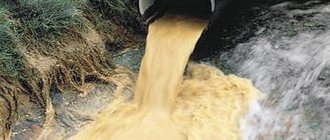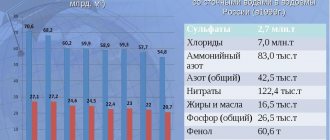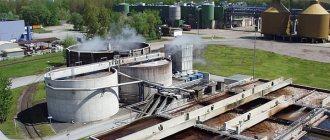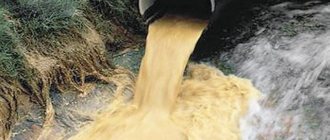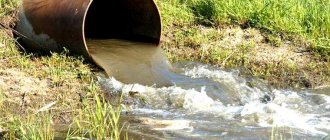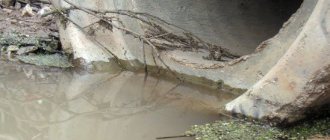The most valuable natural resource is water. It plays an exceptional role in metabolic processes. Human health directly depends on the quality of the water they consume. Therefore, it is so important to develop technological processes that minimize the types of wastewater pollution.
There are more than 100 thousand rivers in Russia, their annual flow is 4700 km3. Analysis of water resources shows that the threat of depletion is currently increasing and water may become scarce. Today, about 60% of the world's population already lacks fresh water.
The reason for the growing shortage of fresh water is population growth, as well as unregulated deforestation and pollution of water bodies due to an unreasonable attitude towards the protection of water resources. It is estimated that there will be a shortage of fresh water within this century. Therefore, it is very important to pay attention to the integrated, economical use of water resources.
Runoff from industrial enterprises, agriculture, and public utilities has a particularly strong influence on the lack of fresh water. A small city, consuming 600 m3 of clean water daily, produces 500 m3 of wastewater.
Clean water without a filter is almost impossible these days.
The shortage of fresh water is caused not by its irreversible consumption, but by the increasingly increasing pollution of water bodies by industrial and domestic wastewater. Severely polluted wastewater comes from the petrochemical, metallurgical, oil refining, chemical, pulp and paper, and food industries. The incorrect use of pesticides and fertilizers in agriculture causes enormous harm.
Wastewater is varied in its composition, which depends on the type of pollutants that enter it. Effluents from the chemical industry, processing and mining enterprises are very harmful.
Discharge of wastewater at high temperatures, for example from thermal power plants, leads to the accumulation of organic substances and disrupts the biorhythm of the reservoir.
It is difficult to purify wastewater from synthetic surfactants contained in detergents. Sometimes they are even present in drinking water. Surfactants significantly impair the self-cleaning ability of water bodies. They enter water bodies as wastewater from laundries, baths, and detergent manufacturers. Surfactants and CMC are also used to intensify production at light industry enterprises, during ore dressing, and during the separation of products in the chemical industry.
Huge harm to water bodies is caused by pesticides that enter them along with melt and rainwater during cultivation of fields, as well as with water from cotton and rice plantations.
Radioactive contamination is dangerous to human life and health. This phenomenon is observed during testing of nuclear weapons under water, during violations of the purification regime for uranium ore, as well as during the processing of nuclear fuel.
Types of wastewater pollution
Basically, all wastewater contains 3 types of contaminants:
- Mineral. These include sand, ore and clay inclusions, solutions of mineral salts, alkalis and acids;
- Vegetable. These include fruit residues and adhesive substances of animal origin. In them, the main chemical substance is carbon;
- Biological and bacterial. This is wastewater from slaughterhouses, municipal services, and biofactories. They contain microorganisms and molds.
Requirements and regulations
Wastewater must be treated to the level of TAC or MPC , especially if it is returned to fishery water bodies. This rule is prescribed in SanPiN 2.1.5.980-00 “Hygienic requirements for the protection of surface waters.”
After biological treatment, BODp should decrease to 15 mg/l, and suspended solids - to 70 mg/l.
After deep cleaning, the BOD value does not exceed 3-5 mg/l, and the concentration of suspended matter does not exceed 1-2 mg/l.
Other requirements and regulations:
- GN 2.1.5.689-98 “Maximum permissible concentrations (MAC) of chemicals in water of water bodies for domestic, drinking and cultural water use”;
- GN 2.1.5.690-98 “Approximately permissible levels (TAL) of chemical substances in water of water bodies for domestic, drinking and cultural water use.”
Types of wastewater
The following types of wastewater are distinguished:
Industrial waste
They can be divided into:
- Polluted. Pollution occurs through the above route;
- Conditionally clean. These include, for example, water for cooling heat engines;
- Domestic and household wastewater. These include wastewater from public buildings, hospitals, kitchens, canteens;
- Agricultural runoff. They contain large quantities of chemical fertilizers and pesticides;
- Atmospheric effluents. They are formed by runoff from industrial sites during melting snow and rain.
Surface and underground waters
They are characterized by the following types of pollution:
- Mechanical contamination. This is mainly characteristic of surface types of pollution. These include an increased content of mechanical impurities;
- Chemical pollution. It is characterized by the presence in water of inorganic and organic substances of a non-toxic and toxic nature;
- Biological and bacteriological. The water contains pathogenic microorganisms, fungi and small algae.
- Radioactive. There are radioactive substances in the water;
- Thermal. This type of pollution is observed when water from nuclear and thermal power plants with elevated temperatures is discharged into reservoirs.
The main source of water pollution is poorly treated wastewater from municipal and industrial enterprises. Pollutants qualitatively change the composition of water. This manifests itself in a change in its physical properties, an unpleasant odor and taste appears, and harmful substances appear in it, which either float on the surface of reservoirs or are deposited at the bottom.
Possible problems
They want to equate the standards for the content of pollutants in treated wastewater to the world standards, and the majority of Russian enterprises use physically outdated equipment .
Purification using technologies developed in the last century does not reduce the level of impurities to the required levels.
Modern equipment is expensive. For example, UV disinfectants are installed only in the capital and several large cities. In most populated areas, the equipment has become so outdated that wastewater is often discharged into water bodies without treatment.
Some private entrepreneurs do not want to invest in the construction of treatment facilities. They dump polluted water into rivers.
Other wastewater treatment problems:
- Selection of an ineffective technological scheme;
- Inability to dispose or bury waste, pollution, and by-products;
- Lack of money for electricity, equipment maintenance and repair, and transportation costs.
Existing problems can only be solved at the legislative level : increase fines for violations, finance city wastewater treatment plants and control the expenditure of money, encourage private owners to introduce new technologies, offering them various discounts and benefits.
Honest inspections should be carried out more often, which can be spontaneous - without warning.
Chemical pollution
Output of surface wastewater with impurities
The quantitative and qualitative composition of all contaminants is varied. But all chemical pollution can be divided into two groups:
- The first category includes pollution containing inorganic impurities. These include wastewater from sulphate and soda plants and processing plants. In their composition, they contain large quantities of heavy metal ions, alkalis and acids. They change the quality composition of water.
- The second group includes wastewater from oil refineries, petrochemical plants, organic synthesis enterprises, and coke production plants. Wastewater contains large quantities of phenols, aldehydes, resins, ammonia, and petroleum products. Their harmful effect is that the organoleptic characteristics of water deteriorate, the oxygen content in it decreases, and the biochemical need for it increases.
Currently, the main pollutant of water bodies is oil and petroleum products. When they enter water, they create a film on its surface, and heavy fractions settle to the bottom. Taste, color, viscosity, surface tension changes. Water acquires toxic properties and poses a threat to humans and animals.
Wastewater from petrochemical plants contains phenol. When it gets into water bodies, the biological processes occurring in them sharply decrease, and the process of self-purification of water is disrupted. There is a carbolic acid smell in the water.
Pulp and paper industry enterprises have a detrimental effect on the life of water bodies. The wood mass oxidizes, a significant consumption of oxygen occurs and, as a result, fry and adult fish die. Insoluble substances and fibers worsen the physical and chemical properties of water. Mole alloys have a harmful effect on water bodies. Tannins are released from bark and rotting wood into the water. The resin absorbs oxygen, which leads to the death of fish. In addition, moth alloys clog rivers and clog their bottoms. At the same time, fish are deprived of spawning grounds and feeding grounds.
Ecology DIRECTORY
The composition of domestic wastewater is more or less homogeneous. Contamination of household wastewater, as shown by numerous studies, is almost independent of climate, living conditions, culture of the population, etc. It can be assumed that, on average, per resident using sewerage, the following daily amount of pollution enters through various wastewater receivers water together with the latter [92]: suspended substances - 35-50 g, ammonium nitrogen - 7-8 g, food chlorides - 8.5-9.0 g, phosphates - 1.5-1.8 g and potassium 3 G.[ …]
The composition of domestic wastewater is more or less uniform; the concentration of contaminants in them depends on the amount of tap water consumed (per inhabitant), i.e. from the water consumption norm.[...]
The complex of household wastewater contaminants serves as a complete substrate for heterotrophic organisms, as it includes sources of carbon nutrition (proteins, fats, carbohydrates), necessary nutrients (nitrogen and phosphorus) and microelements that are always present in drinking water. [...]
There are mineral, organic and biological pollutants in household wastewater. Mineral contaminants include sand, slag particles, clay particles, solutions of mineral salts, acids, alkalis and many other substances. Organic contaminants are of plant and animal origin. Vegetables include the remains of plants, fruits, vegetables, paper, vegetable oils, etc. The main chemical element of plant pollution is carbon. Pollutants of animal origin are physiological secretions of people and animals.[...]
The amount of household wastewater pollution per worker is taken according to the data in Table. 5.9.[...]
Atmospheric wastewater in modern cities contains, in addition to sand and debris washed off the pavements, also organic pollutants, so in terms of their composition they can often be classified as slightly polluted domestic wastewater. [...]
The city's domestic sewage system is one of the most significant sources of reservoir pollution. The consumption of domestic wastewater is very high, it accounts for 80% of the amount of water supplied by the city water supply. These effluents carry a large amount of inorganic, organic and biological pollutants. Some idea of the daily amount of household wastewater pollution per inhabitant is given by the materials in Table. thirty.[ …]
In terms of pollution of water bodies, the pulp industry in Czechoslovakia, compared to other industries in the country, ranks first. Thus, of the total pollution of rivers with organic substances, the pulp industry accounts for more than one third of all pollution on a national scale, and for some areas (for example, Slovakia) this value increases to two thirds. Thus, one pulp mill with a capacity of 100 tons of pulp per day produces the same amount of pollution as the city of Bratislava. As for the harmfulness of this wastewater, it is much higher than that of household wastewater.[...]
Taken together, household wastewater pollution represents a complete substrate for heterotrophic bacteria, therefore, biological methods are usually used for their purification.[...]
The approximate ratio of household wastewater pollution is shown in Fig. 4.1. As you can see, mineral substances in pollution make up 42%, and organic substances - 58%. [...]
According to the main indicators of pollution, household wastewater is much more dangerous in sanitary terms than atmospheric wastewater. The amount of pollution in the annual rainwater runoff is approximately equal to 10-12 days of household water pollution from 1 hectare of urban area (Table 1.1).[...]
The unfavorable effect of wastewater on the general sanitary regime of reservoirs is associated with: a) an excessively high concentration in the water of reservoirs of relatively easily oxidized organic substances of household and industrial wastewater, which causes a violation of the oxygen regime of the reservoir and the occurrence of putrefactive processes; b) with the bactericidal properties of many ingredients of industrial wastewater, as a result of which the normal course of biochemical processes of self-purification of reservoir water from organic pollution of household wastewater occurs. As a result, the pollution zone becomes widespread and persists for a long time.[...]
With regard to industrial wastewater, such calculations have never given satisfactory results, but now, due to the large pollution of domestic wastewater and reservoirs with industrial wastewater, they have become inapplicable for such waters. [...]
In many cases, the degree of pollution of industrial wastewater is so great in comparison with the pollution of domestic wastewater that one stage of biological treatment is not enough. Water must alternately go through two or more stages of purification. However, it is also possible to inoculate wastewater with bacterial cultures that are specifically adapted to a particular wastewater and have a high purification capacity. All these methods, combined under the name “intensive biological treatment methods,” have been tested in laboratory tests in recent years and can be used in practice to treat wastewater from coal, oil and chemical industries. At the same time, high-performance aerators are used to satisfy the increasing oxygen demand of microorganisms. For biological treatment of industrial wastewater, biofilters that are already familiar to us can also be used. [...]
Non-sedimentable and dissolved contaminants of household wastewater are removed with the help of bacteria in biochemical treatment plants, which create conditions that imitate the biochemical treatment processes occurring under natural conditions in rivers; Thus, about 40% of contaminants are destroyed. Many industrial wastewaters containing biochemically oxidizable contaminants can be treated in the same way.[...]
As is known, undissolved contaminants in household wastewater, during their biochemical oxidation, absorb about 30-35% of the total oxygen required for the complete oxidation of all contaminants present in the wastewater. For a number of wastes this value reaches 60 and even 80%. Although the settling of wastewater is provided for by sanitary and technical measures aimed at separating solid sediment, it is nevertheless known that the practical efficiency of the settling tank does not exceed 70-80%, and that even biological treatment does not ensure complete removal of suspended substances, which account for from 15 to 40% of the remaining oxygen demand.[...]
Bacterial and biological contaminants are various microorganisms: yeast and mold fungi, small algae and bacteria, including pathogenic ones - the causative agents of typhoid fever, paratyphoid fever, dysentery, etc. This type of contaminant is characteristic mainly of domestic waters and some types of industrial wastewater (wastewater waters of slaughterhouses, tanneries, wool washing plants, biofactories, etc.). According to their chemical composition, they belong to organic pollution, but are classified as a separate group due to their special interaction with other types of pollution. The approximate ratio of household wastewater pollution is shown in Fig. 4.1. As can be seen from this figure, mineral substances in wastewater pollution account for 42%, and organic substances - 58%. [...]
Since it has been established that water contaminated with domestic wastewater is a carrier of intestinal diseases, it was necessary to find out how to detect the actual or possible presence of pathogenic organisms in water, how to prevent the introduction of pathogenic organisms into water, and how to make water containing pathogenic organisms suitable for drinking.[...]
In table Table 1 shows data on the nature of contamination of household wastewater.[...]
Mention should be made of the effect of ozone on household wastewater pollution in the presence of catalysts. Catalytic oxidation with ozone is usually carried out in the presence of salts and oxides of copper and cobalt, metals of group VIII of the periodic system (mainly Fe, Co, N1). The catalyst can be used in both dissolved and undissolved phases. For example, metal oxides, which serve as a charge for ozone columns during catalytic oxidation, belong to the class of undissolved catalysts. They are spherical or oval particles with a diameter of 0.5-5 mm. The concentration of undissolved catalysts varies widely and depends on the experimental conditions, the type of contact columns and the condition of the catalyst. The concentration of dissolved catalysts can be 10-1000 mg/l.[...]
For a number of ingredients in industrial wastewater, bactericidal properties appear at such low concentrations that the adverse effect on the general sanitary condition of water bodies due to inhibition of the biochemical processes of self-purification from organic pollution of household wastewater turned out to be their limiting feature. Thus, according to this limiting sign of harmfulness, maximum permissible concentrations have been adopted for the following ingredients: copper, zinc, nickel, cobalt, cadmium, trinitrotoluene, etc. (see Table 16). [...]
Due to the fact that surfactants become a constant contaminant of household wastewater, for which the main method of treatment is biochemical, it became necessary to impose special requirements in terms of biological decay for surfactants that are widely used primarily for domestic purposes. [...]
Due to the relative uniformity of human economic and household activities, the composition of household wastewater contaminants is quite uniform and stable.[...]
In sewer technology, the concept of daily pollution rate per inhabitant, introduced by prof. S. N. Stroganov (1923). He found that the amount of ammonia nitrogen in wastewater per inhabitant varies within very narrow limits - from 6 to 8 g; this corresponds to the normal daily intake of digestible protein. S. N. Stroganov pointed out that “neither climate, nor living conditions, nor the culture of the population affect this stable norm.” It has also been established that normal consumption of table salt results in a chloride content of 8 to 9 g per person in wastewater. For phosphates, a norm of 1.5-1.8 g/day per person was obtained. All these results made it possible to recommend standards for calculating the composition of household wastewater pollution per inhabitant per day. In table Figure 10 shows the pollution standards introduced in SNiP 2.04.03-85, as well as those previously defined by S. N. Stroganov.[...]
The composition and quantity (per person using sewerage services) of household wastewater pollution is relatively constant due to the constancy of the physiological processes occurring in the human body and the monotony of everyday business operations.[...]
Filtration (mechanical method of purification). Along with the well-known commonality of the post-treatment processes for domestic and industrial wastewater, there are significant differences in these processes due to the different composition of the filtered suspensions. Wastewater from industrial enterprises, even after biological treatment, contains a significant amount of contaminants characteristic of various industries, for example, ether-soluble substances, oils, resinous substances, cellulose, lignin, etc. These substances can influence the mechanism of the filtration process through the granular load and change the structure sediments to a greater extent than domestic wastewater pollution.[...]
Diseases of viral origin are also observed among the population as a result of the use of water contaminated with domestic wastewater. The accumulation of enteric viruses in water is facilitated by repeated use of water, which may be the reason for the increase in waterborne viral diseases. Particular attention is paid to the infectious hepatitis virus; There is no possibility of immunization against it yet. It is believed that even single viruses can have pathogenic significance. Reviews of waterborne viruses include F. Taylor (1974). Factors of water pollution affect humans not only during drinking, but also during recreational use of water bodies, in which the same types of pollution - chemical, physical and biological - can have an adverse effect.[...]
Such irrigation is one of the types of water reclamation and, at the same time, an effective way to protect natural reservoirs from pollution by household wastewater, and in addition, a means of significantly increasing agricultural yields. With rational irrigation rates, wastewater is completely neutralized in the underlying layers of soil.[...]
Often, simultaneously with the design of settlements and industrial enterprises, it is necessary to design their sewerage system, including wastewater treatment. When developing projects for sewage treatment plants for industrial enterprises, you can use the available data on the composition of wastewater from similar enterprises, i.e., similar in the nature of the use of raw materials, technological processes, etc. When designing treatment facilities for newly constructed settlements or reconstructed cities, the composition wastewater is obtained by calculation. To do this, it is necessary to know the nature and amount of contaminants introduced into wastewater per day from each person using the sewer system, and the water disposal rate in l/day per person. According to SNiP, the amount of household wastewater pollution per inhabitant per day is recommended according to table. 14.3.[...]
The minimum detectable concentration of uric acid is 5 μg/L, which corresponds to 1/100,000 of its concentration in human urine and 1/200 of its concentration in untreated domestic wastewater. In domestic wastewater, there is some relationship between the uric acid content and the coli index, which serves as a quantitative characteristic of contamination in household wastewater. [...]
Urea is one of the most important end products of protein metabolism in humans and animals. The urine excreted by a person per day contains 25-35 g of urea, about g of amino acids, 0.3-1.2 g of uric acid, 1.5-2.4 g of creatinine, etc. All these substances make up the main ingredients pollution of domestic wastewater.[...]
Organic substances contain, in addition to carbon, nitrogen, phosphorus, potassium, sulfur, chlorine compounds, etc. The amount of biochemically oxidized organic substances is characterized by the amount of oxygen that is consumed in a certain time interval (BOD in mg/l). Their total, 5-, 7- and 20-day values (BOD„, BODb, BOD7 and BOD20) are determined. BOD is one of the main indicators of organic pollution in domestic wastewater, as well as wastewater from the food industry. The total content of organic matter is determined by chemical oxidation and is called chemical oxygen demand (COD), expressed in mg/l. The BOD/COD ratio, depending on the composition of the wastewater, varies from 0.8 ... 0.85 (domestic wastewater) to 0.1 ... 0.2 (chemical industry wastewater). [...]
Biologically soft surfactants absorb 35-40% of the theoretically required amount of oxygen in a Warburg apparatus in 6 hours for the chemical oxidation of compounds to final products (CO2, H20, HGEO, , NH3). Such substances at urban biological treatment plants are oxidized by more than 80%, i.e., the same as most organic pollutants in household wastewater. [...]
Biological contamination
The world's population is growing, old cities are expanding and new ones are growing, which leads to an increase in runoff into inland water bodies. Domestic wastewater is a source of pollution of rivers and lakes with helminths and pathogenic bacteria.
Wastewater contains 60% organic substances. These include biological pollution in medical and sanitary waters, municipal waters and waste from wool washing and tanning enterprises.
When treating wastewater, the greatest difficulties are caused by organic impurities. When they rot, they poison the soil, air and water. Wastewater must be removed outside the cities and organic matter must be mineralized. The total volume of microorganisms in wastewater is about 1 m3 per 100 m3 of wastewater. Among the bacteria and various microorganisms there are also pathogenic ones, for example, the causative agents of cholera, typhoid fever, dysentery and other diseases. Most of the wastewater is potentially hazardous to humans and animals. To prevent water bodies from becoming polluted with harmful substances, wastewater must be treated. Partial purification also occurs in the reservoir itself. The degree of wastewater treatment is determined by a special calculation and agreed with the fishery and sanitary inspection authorities.
Difference between cleansing and disinfecting
During cleaning, mechanical and chemical impurities are removed .
Important. The purpose of disinfection is to remove living microorganisms that cause harm to humans.
Harmful microorganisms include pathogenic and opportunistic bacteria, their spores, viruses, fungi, helminths and their eggs.
Disinfection methods:
- Chemical : water treatment with ozone, chlorine dioxide, sodium hypochlorite, polymer antiseptics. These substances kill pathogens or make them unable to reproduce;
- Physical : water treatment with ultraviolet rays, ultrasound;
- Complex : combining chemical and physical methods.
Thermal pollution
If heated water from thermal power plants is discharged into reservoirs, this causes thermal pollution. Warm water contains less oxygen, and the thermal regime changes dramatically. This has a negative impact on the flora and fauna of the reservoir. Blue-green algae begin to develop in it, which has a detrimental effect on the number of inhabitants of reservoirs.
Today, the task of protecting water resources from pollution and depletion and their rational use is especially acute. One of the areas of work to protect water resources is the use of drainless water supply cycles. In this case, wastewater does not need to be discharged; it can be reused in technological processes. Drainless cycles will eliminate water discharges.
The degree of contamination of wastewater can be significantly reduced by removing valuable impurities from it. If water is used to cool the system, then air cooling should be considered, which will reduce overall water consumption by 80%. In this regard, it is very important to develop new equipment that uses a minimum of water for cooling.
The increase in the whirlpool is significantly influenced by the introduction of wastewater treatment methods with high efficiency, for example, physical and chemical ones, where the use of reagents is the most effective. The active implementation of the physicochemical method together with biochemical treatment can significantly solve the problems of wastewater treatment. In the near future it is planned to carry out wastewater treatment using membrane methods.
Cleaning methods
In nature, everything is provided for, so the water in reservoirs has the ability to self-purify. However, this process does not occur quickly, so natural purification methods will not cope with a large flow of wastewater. For this reason, wastewater disposal without preliminary treatment is prohibited.
Safe wastewater disposal is treatment to remove as much contaminants as possible from the water. Organizing wastewater treatment and disposal is an important task that needs to be solved when constructing a building. The methods by which wastewater is treated can be divided into several groups, these are:
- Mechanical;
- Physico-chemical;
- Chemical;
- Biological.
Each of these methods can be used separately, but the best results can be achieved when using a combination of several methods.
Mechanical methods
When using mechanical cleaning, two methods are used:
- Advocacy;
- Filtration.
In the first case, wastewater settling tanks are used. Here, substances are divided into fractions depending on their specific gravity. For filtration, various filters are used that allow you to separate large inclusions.
When using the mechanical method, it is possible to achieve the removal of 65-70% of impurities from domestic wastewater and approximately 95% of impurities from storm drains. Therefore, settling or clarification is only the first stage; then domestic wastewater needs additional treatment.
Most often, wastewater treatment is carried out using biological methods. Additionally, wastewater disinfection can be applied using ozonizers or ultraviolet light.
Chemical methods
When using chemical methods, specially selected chemical reagents are added to the cleaned environment. These substances react with contaminants to form insoluble substances that settle to the bottom of the sump. When using a chemical method, it is possible to remove about 95% of contaminants dissolved in water and about 25% of undissolved substances.
Physico-chemical methods
When using these methods, wastewater is subjected to special treatment to remove both dissolved and undissolved contaminants. The most commonly used methods are:
- Coagulation. In this case, special substances are introduced into the drain, under the influence of which small suspended particles stick together, forming large aggregates that settle to the bottom.
- Flocculation. This process has the same principle as coagulation, but the reagents used when using it are different.
- Extraction. This is a method of extracting certain substances from a liquid. It is quite expensive, so it is used when the extracted substances can be reused.
- Ultrafiltration. Ultrafilters are used in industrial sewerage systems if the system provides for the use of recycled water. Ultrafiltration allows you to separate high molecular weight compounds from low molecular weight ones.
As a rule, physicochemical methods are used to process industrial wastewater, since it can contain a large number of different chemicals.
Bioremediation methods
Biological methods are used to process domestic wastewater containing a lot of organic matter. They are based on the use of naturally occurring bacteria, which are used in natural self-cleaning processes. During their life, bacteria process organic inclusions, decomposing them into safe components.
The simplest biotreatment methods are used in cesspools and septic tanks. Here, organic waste that has settled to the bottom undergoes anaerobic fermentation, that is, it is processed by microorganisms that can exist without oxygen.
In modern treatment plants, aerobic cleaning is additionally used; for this, air oxygen is supplied to the working area. Aerobic processes are much faster and allow more contaminants to be removed. The biorefinery station has elements such as aerators and electric pumps, that is, it is volatile and requires a power supply.
Companies
Mosvodokanal is responsible for cleaning urban wastewater in the capital.
This is a public utility company that operates wastewater treatment plants:
- Kuryanovsky;
- Lyubertsy;
- Yuzhno-Butovskie;
- Zelenogradskie.
Reference. Every day they receive more than 3 million cubic meters. m of domestic and storm water.
All large cities have their own wastewater treatment plants, which are controlled by the local water utility.
Private companies design and build treatment facilities for industrial enterprises and business complexes. A large company in Russia is Ecolos . It produces wastewater treatment plants of various sizes on a turnkey basis, focusing on the needs of customers.
Another large company with similar activities is REATORG . She is engaged in environmental engineering, repair and construction work, design and estimate calculations, etc. The company is focused on industrial facilities.
Definition
Enterprise wastewater includes water that, after being used in the industrial cycle, is contaminated with production waste.
Almost every industry uses water in its production process, which contaminates it with waste and can change its physical characteristics, such as temperature. Nowadays, in modern enterprises, wastewater is divided into categories according to composition, according to the conditions of disposal and treatment, as well as further use in a closed water supply cycle.
